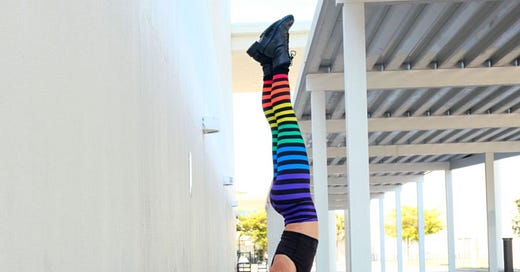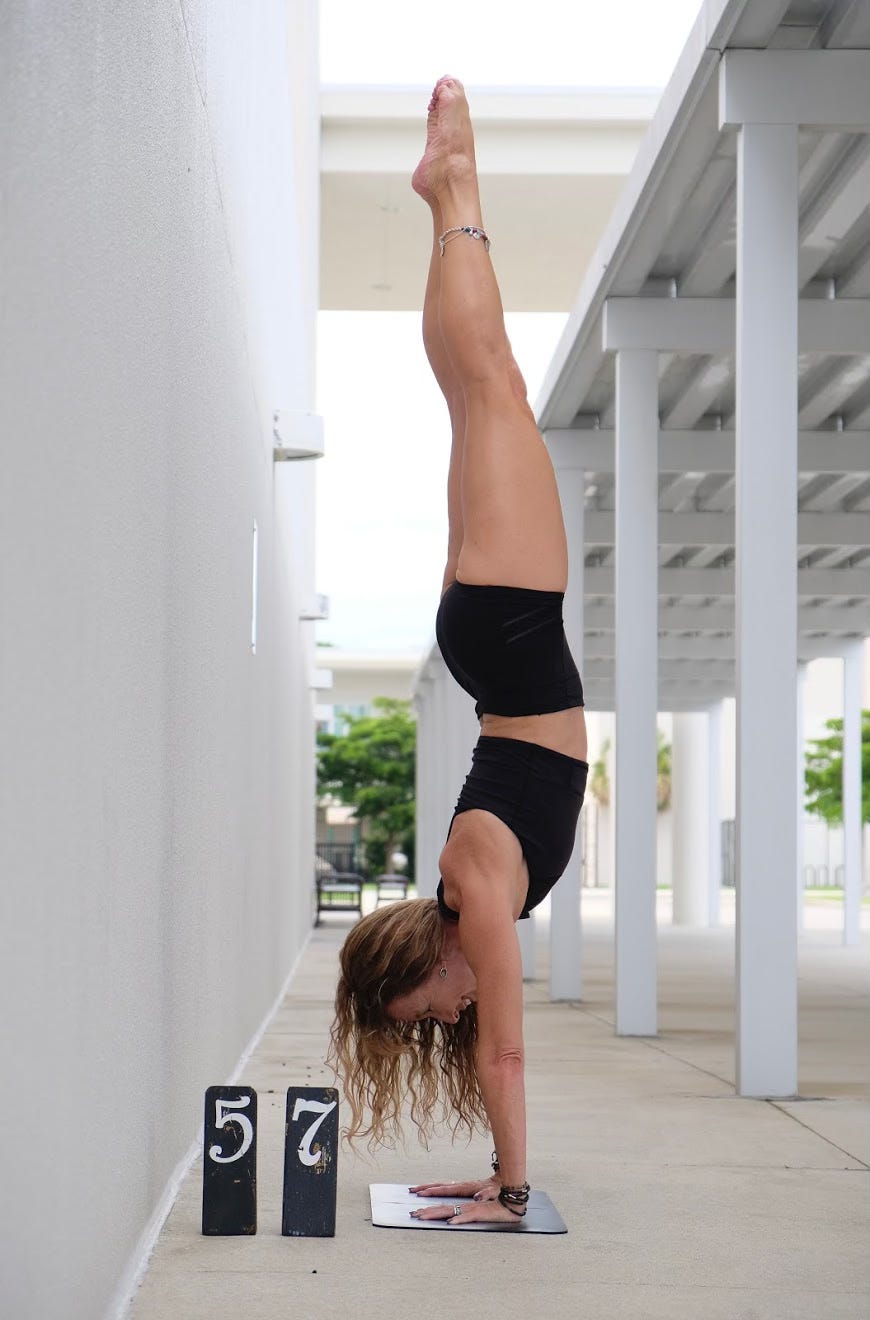What Learning a Freestanding Handstand at 57 Taught Me About Aging, Strength, and Patience
Lo que aprender a hacer el pino libre a los 57 me enseñó sobre el envejecimiento, la fuerza y la paciencia
Español abajo
The Goal That Sparked a Journey
At 55, I declared publicly that I would learn to do a freestanding handstand by the time I turned 60.
I had experienced a brief moment of “hang time” with my feet over my head during a practice, and the exhilaration was enough to hook me. I wanted more of that feeling, not just physically, but emotionally and spiritually.
To my surprise, I met my goal well ahead of schedule. That handstand photo on my 57th birthday? That was the celebration of a couple of years of effort, consistency, and showing up for myself in every way.
Beyond the Pose: What Yoga Means to Me
I’ve practiced yoga daily for years, but I don’t mean just the poses. Yoga is an eight-limbed path, and while asana (the physical postures) gets the most attention online, it’s only one part of the picture. My practice also includes breathwork, meditation, self-discipline, and ethical observances that extend far beyond the mat.
Truthfully, I don’t even know if handstand drills count as yoga. But the journey felt like a spiritual one nonetheless.
The Power of Presence
Once I started training regularly, I noticed something remarkable. From the moment my feet left the floor to the moment I landed again, time seemed to slow down. Everything outside of my breath and body faded away. Each time I held the pose, even for a few seconds, it felt like a little miracle.
And as fleeting as it was, the feeling stayed with me, along with a growing sense of confidence that began to ripple into other areas of my life.
Progress Isn’t Linear
I’ve been active my entire life, but in my 50s, I had to practice more patience than ever. Some days I felt strong and light. Other days, it was as if I had forgotten everything I’d learned. But over time, I began to trust the process. Progress was happening, even if it wasn’t always obvious in the moment.
Watching videos and photos helped me see the arc of my journey. I had come a long way from the days when just getting my feet off the ground felt like a win.
Support Along the Way
There are countless online resources for learning handstands, but I chose to train with Kerry Verna, also known as @BeachYogaGirl. Her Handstand Trainer eBook was a game-changer.
Later, I found Sheila Donnelly, a handstand coach who specializes in working with women over 40. Her encouragement helped me push through the drills (even the boring ones) and stay consistent without being overly rigid. I even interviewed her about her own handstand journey and what she teaches other midlife women.
What Comes After a Goal?
Just because I hit my target doesn’t mean I stopped practicing. Once your body learns something, it remembers. But there’s always more to refine: better alignment, longer holds, softer landings.
I still take breaks from handstands when I need to. I’m not trying to be perfect. But I no longer assume that age is a reason not to do something. I see women in their 60s and beyond exploring strength, flexibility, and balance, and I feel lucky to be among them.
Evolving Goals in My 60s
After achieving my handstand goal in my 50s, I found myself wanting a new challenge as I entered my 60s. That’s when I set my sights on unassisted pull-ups, a movement I’d never mastered, even in my younger years.
Despite having suffered a partial rotator cuff tear that took me out of commission for a while, I kept training as much as I safely could. I lost some muscle mass and strength during that time, but I didn’t stop moving. I adapted. And slowly, I rebuilt.
At 61, I’ve now done four unassisted pull-ups. No bands. No jumping. Just grit and patience and breath, much like the handstand journey. They aren´t perfect, but I will continue working on them. And yes, I’m slowly getting back on my hands too. The wall is still there when I need it, but some days I don’t. Some days I trust myself again.
A Note About Safety
As of this writing, I don’t have osteoporosis or osteopenia. My spine, wrists, shoulders, and neck are all healthy. That said, I’m mindful of my body. I’m not interested in pushing myself to the point of injury. I’ve come too far for that.
This mindset of slow, steady, sustainable progress has taken me a lifetime to develop. And even more than that, I’ve learned to release the idea of a race entirely.
Why This Matters
Achieving a freestanding handstand at 57 and a series of unassisted pull-ups at 61 taught me that limitations are often internal. If I could do those things, what else might be possible?
We don’t have to stop setting goals because we’re over 50, 60, or 70. We just have to set them on our terms, with wisdom, self-respect, and a good dose of curiosity.
Español
El objetivo que inició el camino
A los 55 años declaré públicamente que quería aprender a hacer el pino libre antes de cumplir los 60.
Había tenido una breve sensación de estar suspendida en el aire, con los pies por encima de la cabeza, durante una práctica, y esa descarga de adrenalina fue suficiente para engancharme. Quería volver a sentir eso. No solo a nivel físico, también emocional y espiritual.
Para mi sorpresa, alcancé mi objetivo mucho antes de lo previsto. Aquella foto haciendo el pino en mi 57º cumpleaños fue la celebración de años de constancia, esfuerzo y de mostrarme para mí misma, día tras día.
Más allá de la postura: lo que significa el yoga para mí
Practico yoga a diario, pero no me refiero solo a las posturas. El yoga es un camino de ocho pasos, y aunque el asana (la práctica física) suele acaparar toda la atención en redes sociales, en realidad es solo una pequeña parte del conjunto. Mi práctica también incluye pranayama (respiración), meditación, autodisciplina y principios éticos que aplico fuera de la esterilla.
Sinceramente, ni siquiera estoy segura de que los ejercicios de pino se puedan considerar yoga. Pero el proceso sí me pareció profundamente espiritual.
El poder del momento presente
Cuando empecé a entrenar con regularidad, noté algo curioso. Desde el momento en que los pies se elevan hasta que vuelven a tocar el suelo, el tiempo parece detenerse. Todo lo que no sea mi respiración y mi cuerpo desaparece. Cada vez que consigo mantener la postura, aunque solo sean unos segundos, se siente como un pequeño milagro.
Y aunque esa sensación es breve, permanece conmigo. Va acompañada de una confianza creciente que acaba por reflejarse en otras áreas de mi vida.
El progreso no es lineal
Siempre he sido una persona activa, pero en mis cincuenta aprendí a tener más paciencia conmigo misma. Algunos días me sentía fuerte y ligera. Otros parecía haber olvidado todo lo aprendido. Pero con el tiempo, empecé a confiar en el proceso. El progreso estaba ocurriendo, aunque no siempre se notara de inmediato.
Ver vídeos y fotos de mi práctica me ayudó a comprender todo el recorrido. Había avanzado muchísimo desde aquellos primeros días en los que levantar los pies del suelo ya era un logro.
Apoyo en el camino
Hay infinidad de recursos online para aprender a hacer el pino, pero yo decidí entrenar con Kerry Verna, conocida como @BeachYogaGirl. Su ebook Handstand Trainer fue una gran ayuda.
Más adelante descubrí a Sheila Donnelly, una entrenadora especializada en mujeres mayores de 40 años. Su apoyo fue clave para que no abandonara los ejercicios más repetitivos, y me ayudó a mantener la disciplina sin volverme rígida. Incluso la entrevisté para conocer más sobre su propio camino y su método con mujeres de mediana edad.
Qué pasa después de lograr el objetivo
El hecho de haber alcanzado mi meta no significó que dejara de practicar. Una vez que el cuerpo aprende algo, lo recuerda. Pero siempre hay margen para mejorar: una alineación más limpia, aguantar más tiempo, aterrizar con más suavidad.
A veces hago pausas en los entrenamientos de pino. No aspiro a la perfección. Lo que ya no hago es asumir que la edad es una razón para no intentarlo. Sigo a muchas mujeres de 60 años o más que practican fuerza, equilibrio y flexibilidad, y me inspira profundamente formar parte de esa comunidad.
Nuevos retos en mis 60
Después de cumplir mi objetivo del pino en los 50, quise plantearme un nuevo reto al entrar en los 60. Fue entonces cuando decidí trabajar las dominadas sin asistencia, algo que nunca había logrado ni siquiera de joven.
A pesar de haber sufrido una rotura parcial del manguito rotador, que me dejó fuera de juego durante un tiempo, seguí entrenando todo lo que podía sin ponerme en riesgo. Perdí masa muscular y fuerza, pero no dejé de moverme. Me adapté. Y poco a poco, fui recuperando.
Hoy, con 61 años, he conseguido hacer cuatro dominadas sin ayuda. Sin bandas. Sin impulso. Solo fuerza, paciencia y respiración, muy parecido al camino del pino. No son perfectas, pero ahí sigo, practicando. Y sí, poco a poco también estoy volviendo a ponerme sobre las manos. La pared sigue ahí si la necesito, pero hay días en los que ya no la busco. Días en los que vuelvo a confiar en mí.
Una nota sobre la seguridad
A día de hoy no tengo osteoporosis ni osteopenia. Mis muñecas, espalda, hombros y cuello están en buen estado. Aun así, soy muy consciente de mis límites. No tengo ninguna intención de poner en riesgo mi salud física. Me ha costado mucho llegar hasta aquí.
Este enfoque, lento pero constante, es el fruto de toda una vida de aprendizaje. Y más importante aún, he aprendido que no hay ninguna carrera que ganar. No hay prisa. Solo la alegría de marcarse un reto que en su momento parecía imposible, y que al lograrlo, me recordó que si fui capaz de hacer el pino libre por primera vez a los 57, entonces soy capaz de mucho más.








Excellent story. Thanks for this.